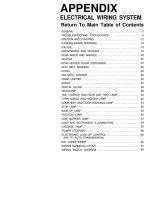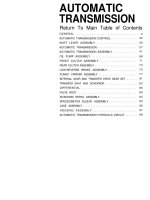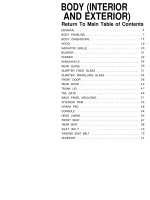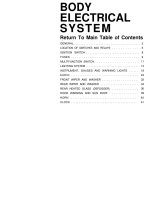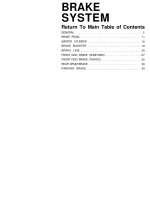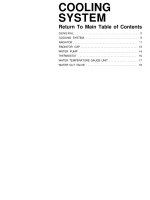Xe ô tô hyundai excel toàn tập hyundai excel - P1
Bạn đang xem bản rút gọn của tài liệu. Xem và tải ngay bản đầy đủ của tài liệu tại đây (1.54 MB, 65 trang )
AIR
CONDITIONING
SYSTEM
Return To Main Table of Contents
GENERAL
.......................................................
2
SERVICE ADJUSTMENT PROCEDURES
.......................
10
HEATER
.......................................................
30
VENTILATORS
................................................
37
COMPRESSOR
............................................... 40
COOLING UNIT
...............................................
58
CONDENSER
.................................................
62
RECEIVER DRIER
..........................................
63
CONDENSER FAN AND RELAY
............................... 64
A/CON RELAY AND RESISTOR
...............................
65
GENERAL
GENERAL
SPECIFICATIONS (DKK)
Heater assembly
Type
Performance Kcal/h (B.T.U./h)
Heater control assembly
Air-mix, warm water type
3,800 (15,000)
Control knob
Air-conditioning
Cooling capacity Kcal/h (B.T.U./h)
Compressor
Model
No. of cylinders and displacement cc/Rev.
Maximum allowable speed
Magnetic clutch
Type
Voltage, power consumption
Control
Idle up device
Frost prevention °C (°F)
Protective equipment
High pressure switch
Low pressure switch
Fusible plug
OFF: 2,647 kPa (384 psi, 27 kg/cm
2
),
ON: 2,059 kPa (299 psi, 21 kg/cm
2
)
OFF: 206 kPa (30 psi, 2.1 kg/cm
2
),
ON: 196 kPa (28 psi, 2kg/cm
2
)
103°C (217°F)
Refrigerant and quantity gr. (oz., lb)
R-12, 850-1,000 (30-35, 1.9-2.2)
3,300 (13,000)
DKS - 15BH
6 cylinders, 153
7,000 rpm
Electromagnetic, single-plate dry clutch
DC 12V, 45W
850-900 rpm
Fin mounted thermostat
OFF: - 1° - 1°C (30° - 34°F)
ON: 3° - 5°C (38° - 41°F)
SERVICE STANDARD
Air-conditioning
Amount of deflection of V belt
Engine idling speed
Clutch clearance
8-10 mm (0.3-0.4 in.)
850-900 rpm
0.3-0.6 mm (0.01-0.02 in.)
LUBRICANTS
Heater assembly
Heater control lever
Recommended lubricant
Multipurpose grease
SAE J310a, NLGI grade #2
Quantity
As required
Air-conditioner
Compressor oil
FREOL DS-83P
150 cc (5.1 US fl oz, 5.3 Imp fl oz)
97-2
GENERAL
SPECIFICATIONS (MANDO)
Heater assembly
Type
Performance kcal/h (B.T.U./h)
Heater control assembly
Air-conditioning
Cooling capacity Kcal/h (B.T.U./h)
Compressor
Model
No. of cylinders and displacement cc/Rev.
Maximum allowable speed
Magnetic clutch
Type
Voltage, power consumption
Control
Idle up device
Front prevention °C (°F)
Protective equipment
High pressure switch
Low pressure switch
Fusible plug
OFF: 2,647 kPa (384 psi, 27 kg/cm
2
)
ON: 2,059 kPa (299 psi, 21 kg/cm
2
)
OFF: 206 kPa (30 psi, 2.1 kg/cm
2
),
ON: 196 kPa (28 psi, 2 kg/cm
2
)
103°C (217°F)
Refrigerant and quantity gr. (oz., lb)
R-12, 850-1,000 (30-35, 1.9-2.2)
Air-mix, warm water type
3,800 (15,000)
Control knob
3,300 (13,000)
SD-709
7 cylinders, 155.
7,000 rpm
Electromagnetic, signal-place dry clutch
DC 12V, 49W
850-900 rpm
Fin mounted thermostat
OFF: -1° - 1°C (30° - 34°F),
ON: 3° - 5°C (38° - 41°F)
SERVICE STANDARDS
Air-conditioning
Amount of deflection of V belt
Engine idling speed
Clutch clearance
8-10 mm (0.3-0.4 in.)
850-900 rpm
0.4-0.78 mm (0.016-0.031 in.)
LUBRICANTS
Recommended lubricant
Quantity
Heater assembly
Heater control lever
Multipurpose grease
SAE J310a, NLGI grade #2
As required
Air-conditioner
Compressor oil
SUNISO 5GS
135 cc (4.6 US fl oz, 4.8 Imp fl oz.)
97-3
GENERAL
SPECIAL TOOLS
A: DKS-15BH
B: SD-709
97-4
GENERAL
A: DKS-15BH
B: SD-709
97-5
GENERAL
Tool
(Number and name)
09977-21811
Bearing remover and
installer and pulley
installer
Illustration
Applicable Model
Use
A
B
1) Removal and installation of
bearing from the pulley (use
with 09216-21300)
0
2) Installation of pulley
A: DKS-15BH
B: SD-709
97-6
GENERAL
HEATER
Symptom
The temperature cannot
be regulated by operating
the temperature control lever
on the panel
No ventilation even when
the mode control lever
is operated
Abnormal sound from
blower motor
Duct enters passenger
compartment
AIR CONDITIONER
Symptom
No blower operation
Insufficient air
Probable cause
Stuck water valve
Remedy
Repair or replace the water
valve
Incorrect adjust installation of warm
Adjust the warm water flow
water flow control cable
control cable
Incorrect adjustment of water
Adjust the mode control cable
valve link
Incorrect adjustment of change
over dampers
Loose duct connection
Adjust the mode control cable
Connect the duct securely or
replace the packing
Foreign material inside blower
Incorrect balance of blower
motor or fan
Damaged blower
Ventilator duct connection
malfunction
Incorrect adjustment of inside/
outside air changeover damper
Remove foreign material
Replace the blower motor or fan
Replace
Connect the duct securely or
replace the packing
Adjust the inside/outside fresh
air changeover cable
Probable cause
Blown “BLOWER” fuse
Malfunction blower motor
Faulty resistor
Malfunction blower control switch
Open or loose connection in electric
circuit
Obstruction in the inlet of the blower
unit
Clogged evaporator
Frosted evaporator
Leaking air
Blown “COMP.” Fuse
Replace
Remedy
Replace
Replace
Replace
Replace
Repair open-circuited point
Remove obstruction
Clean evaporator with
compressed air
Check thermostat
Check for leakage on both
sides of cooling unit and
air ducts
97-7
GENERAL
Symptom
Compressor does
not run, or runs
poorly
Refrigerant pressure
is abnormal
Low pressure
is too high
Low pressure
is too low
Probable cause
Malfunctioning A/C relay
Malfunctioning dual pressure switch
Malfunctioning thermostat
Malfunctioning A/C switch
Malfunctioning blower switch
Blown “A/C” fuse and/or “BLOWER”
fuse
Check operation
Check operation
Check operation
Check operation
Check operation
Replace
Loose compressor drive belt
Battery voltage too low
Internal malfunction of compressor
Short circuit in the magnet coil
Oil on clutch face
Gap between drive plate and pulley
too large
Readjust
Recharge battery
Repair or replace
compressor
Replace
Clean or replace clutch
Adjust gap
Open circuit in the magnet coil
Replace
Open or loose connection in electric
Repair open-circuited
circuit
point
Remedy
Normal pressure are:
High pressure . . . . .
1,470-1,760 kPa (213-256 psi, 15-18 kg/cm
2
)
Low pressure .............
190-290 kPa (28-42 psi, 1.9-2.9 kg/cm
2
)
When, ambient temperature
. . . . . . . . . . . . . . . . . . . . . . . . . .
35°C (95°F)
Engine speed
. . . . . . . . . . . . . . . . . . . . . . . . . . . . . . . . . . . . . . . . .
1,500 rpm
Internal malfunction of compressor
Repair or replace
compressor
Faulty contact at sensing bulb of the
expansion valve
Faulty insulation at sensing bulb of the
expansion valve
Expansion valve opening is too large
Insufficient refrigerant
Receiver-Drier clogged
Expansion valve clogged
Faulty thermostat
Frosted piping
Repair
Repair
Repair
Charge refrigerant
Replace
Replace
Check operation
Clean or replace piping
97-8
GENERAL
Symptom
High pressure is too high
High pressure is too low
Probable cause
Remedy
Insufficient cooling of the condenser
Check and clean condenser
Too much refrigerant
Discharge refrigerant
Air in system
Evacuate and charge system
Malfunctioning condenser fan motor
Check operation
Insufficient refrigerant Charge refrigerant
Internal malfunction of compressor
Repair or replace compressor
SERVICE ADJUSTMENT PROCEDURES
SERVICE ADJUSTMENT PROCEDURES
CHECK AND ADJUSTMENT
After installation, check the following points and confirm that
everything is in order, and then charge the gas, adjust the idling,
and make the adjustment, performance test and the operation
test.
1. Check for any abnormal vehicle performance, etc. which might
have been caused by installation of the equipment.
2. Check the magnetic clutch for operation (without turning the
compressor).
3. Check for any parts left unmounted or any tool left behind in the
vehicle.
4. Check the belt for improper tension.
Belt deflection
Drive belt
. . . . . . . . . . . . . . . . . . . . . . . .
7-9 mm (0.28-0.35 in.)
Air conditioner compressor belt . . . . 8-10 mm (0.32-0.40 in.)
97-10
SERVICE ADJUSTMENT PROCEDURES
ADJUSTMENT OF FAST IDLE CONTROL DEVICE
(F.I.C.D)
The vacuum system is designed to perform the F.I.C.D. raises
the idling speed of the engine ensure better to cooling when the
car is stationary.
1. Warm up the engine.
2. Make sure engine is at correct idling speed with air conditioner
in the “OFF” position.
3. Set the engine speed to the specified rpm by adjusting screw
with air conditioner in the “ON” position..
Specified rpm: 850-900 rpm
4. Depress and release accelerator pedal several times, and make
sure that engine speed returns to the specified rpm.
97-11
SERVICE ADJUSTMENT PROCEDURES
REFRIGERATION CYCLE
97-12
SERVICE ADJUSTMENT PROCEDURES
AIR CONDITIONER COMPONENTS
DUAL PRESSURE SWITCH
Low pressure control
When refrigerant pressure exceeds (206 kPa (2.1 kg/cm
2
, 30
psi), refrigerant pressure overrides the force of spring A. In this
case, the metal diaphragm remains intact and the movable
contact point itself moves in the direction of the arrow, thereby
closing the contact point (1), turning on, resulting in normal
operation.
When refrigerant pressure falls below 196 kPa (2.0 kg/cm
2
, 28
psi), the force of spring A opens the contact point (1), turning off,
and therefore turning the compressor off.
High pressure control
When refrigerant pressure exceeds 2,647 kPa (27 kg/cm
2
, 284
psi), refrigerant pressure overrides the metal diaphragm resist-
ance. The metal diaphragm deforms and moves the pin in the
direction of the arrow, thereby opening the contact point (2),
turning off, and therefore turning the compressor off.
When pressure falls below 2,059 kPa (21 kg/cm
2
, 300 psi), the
metal diaphragm returns to the original state, closing the con-
tact point (2), turning on, resulting in normal operation.
SERVICE ADJUSTMENT PROCEDURES
SERVICE ADJUSTMENT PROCEDURES
SAFETY PRECAUTIONS
1. The R-12 liquid refrigerant is highly volatile. A drop on the skin
of your hand could result in localized frostbite. When handling
the refrigerant, be sure to wear gloves.
2.
If the refrigerant splashes into your eyes, wash them with clean
water immediately. It is standard practice to wear goggles or
glasses to protect your eyes, and gloves to protect your hands.
3. The R-12 container is a highly pressurized vessel. Never leave it
in a hot place, and check to be sure that the storage temperature
is below 52°C (126°F).
4. A halide leak detector is often used to check the system for
refrigerant leakage. Bear in mind that R-12, upon coming into
contact with flame (this detector burns like propane to produce
a small flame), produces phosgene, a toxic gas.
INSTALLATION OF MANIFOLD GAUGE SET
1. Close both hand valves of the manifold gauge fittings.
2. Install the charging hoses of the gauge set to the fittings.
Connect the low-pressure hose to the low-pressure service
port, and the high-pressure hose to the high-pressure service
port.
Tighten the hose nuts by hand.
NOTE
Fittings for attaching the manifold gauge set and located on
the compressor and the high pressure hose.
97-14
SERVICE ADJUSTMENT PROCEDURES
HANDLING REFRIGERANT SERVICE TAP VALVE
1. Before connecting the valve to the refrigerant container, turn
the handle fully counterclockwise.
2. Turn the disc counterclockwise until it reaches its highest
position.
3.
Connect the center hose to the valve fitting. Turn the disc fully
clockwise by hand.
4. Turn the handle clockwise to make a hole in the sealed top.
5. Turn the handle fully counterclockwise to fill the center hose
with air. Do not open the high-and low-pressure hand valves.
6.
Loosen the center hose nut connected to the center fitting of the
manifold gauge.
7. Allow air to escape for a few seconds, and then tighten the nut.
DISCHARGING THE REFRIGERATION SYSTEM
1. Connect the manifold gauge set to the system.
2. Place the free end of the center hose on a shop towel.
3. Slowly open the high-pressure hand valve to adjust the refrig-
erant flow. Open the valve only slightly.
CAUTION
If refrigerant is allowed to escape too fast, compressor oil
will be drawn out of the system.
4. Check the shop towel to make sure no oil is being discharged.
If oil is present, partially close the hand valve.
5. After the manifold gauge reading drops below 434 kPa (3.5
kg/cm*, 50 psi), slowly open the low-pressure hand valve.
6.
As the system pressure drops, gradually open both the high-and
the low-pressure hand valves until both gauges read 0 kPa (0
kg/cm
2
, 0 psi).
97-15
SERVICE ADJUSTMENT PROCEDURES
EVACUATING REFRIGERANT SYSTEM
NOTE
It is necessary to evacuate the air conditioning system any
time the system has been serviced to the extent that it has
been discharged. Evacuation is necessary to rid the system
of all air and moisture that may have been allowed to enter
the unit.
After installation of a component, the system should be
evacuated for approximately 15 minutes. A component in
service that has been opened for repair should be evacuated
for 30 minutes.
1. Engine should be off.
2. Connect manifold gauge set to compressor gauge fittings.
Close both high and low pressure valves.
3. Make sure refrigerant has been discharged from system.
4. Connect the center hose of the gauge set to the vacuum pump
inlet.
5. Start the vacuum pump and then open the high and low mani-
fold pressure valves.
6. After about ten minutes, check that the low pressure gauge
reads more than 94.39 kPa (0.96 kg/cm*, 13.7 psi) vacuum. If
the pressure rises or the specified negative pressure can not
be obtained, there is a leak in the system. In this case, repair
the leak as described in the following.
(a) Close both the manifold valves and stop the vacuum pump.
(b) Charge system with a can of refrigerant [about 0.4 kg (0.9
Ibs.)]. Refer to Charging Refrigerant.
(c) Check for refrigerant leakage with a leak detector.
Repair any leakage found. Refer to Checking Refrigerant
leak.
(d) Discharge refrigerant again, and then evacuate system.
If not leaks found, continue evacuating the system.
7. One again, operate the vacuum pump.
8. Open both manifold pressure valves to obtain 94.39 kPa (0.96
kg/cm*, 13.7 psi) of vacuum.
9. After low pressure manifold gauge indicates as close to 94.39
kPa (0.96 kg/cm*, 13.7 psi) as possible, continue evacuating
for 15 minutes.
10. After evacuating for 15 minutes, close both manifold pressure
valves and stop the vacuum pump. Disconnect the hose from
the vacuum pump. The system is new ready for charging.
97-16
SERVICE ADJUSTMENT PROCEDURES
CHARGING REFRIGERANT SYSTEM (Vapor)
NOTE
This step is to charge the system through the low pressure
side with refrigerant in a vapor state. When the refrigerant
container is placed rightside up, refrigerant will enter the
system as a vapor.
1.
Install the refrigerant can tap valve as described in Handling the
Refrigerant Service Tap Valve section.
2. Open the low pressure valve. Adjust the valve so that the low
pressure gauge does not read over 412 kPa (4.2 kg/cm*, 60 psi).
3.
Put the refrigerant container in a pan of warm water (maximum
temperature 40°C or (104°F) to keep vapor pressure in the
container slightly higher than vapor pressure in the system.
4. Run the engine at fast idle, and operate the air conditioner.
CAUTION
Be sure to keep the container upright to prevent liquid refrig-
erant being charged into the system through the suction side,
resulting in possible damage to the compressor.
5. Charge the system with more than one container (400g, 0.9 lb)
to the specified amount. Then, close the low pressure valve.
Specified amount: 0.85-1.0 kg (1.9-2.2 lb)
NOTE
A fully charged system is indicated by the receiver sight glass
being free of any bubbles.
When refrigerant charging speed is slow, immerse refriger-
ant can in water, heated to a temperature of about 40°C
(104°F).
WARNING
o Under any circumstances the refrigerant can must not be
warmed in water heated to a temperature of over 52°C
(125°F).
o A blow torch or stove must never be used to warm up the
can.
97-17
SERVICE ADJUSTMENT PROCEDURES
CHARGING REFRlGERANT SYSTEM (LIQUID)
NOTE
This step is to charge an empty system through the high
pressure side with refrigerant in a liquid state. When the
refrigerant container is held upside down, refrigerant will
enter the system as a liquid.
CAUTION
Never run the engine when charging the system through the
high pressure side.
Do not open the low pressure valve when the system is being
charged with liquid refrigerant.
1. Close both high and low pressure valves completely after the
system is evacuated.
2.
Install the refrigerant can tap valve as described in Handling the
Refrigerant Service Tap Valve secton.
3. Open the high pressure valve fully, and keep the container
upside down.
4. Charge the system with more than one container (400 g, 0.9
lb) to the specified amount by weighing charged refrigerant
with a scale. Overcharging will cause discharge pressure (high
side) to rise. then, close the high pressure valve.
Specified amount: 0.85-1.0 kg (1.9-2.2 lb)
NOTE
A fully charged system is indicated by the receiver sight glass
being free of any bubbles.
If the low pressure gauge does not show a reading, the sys-
tem is clogged and must be repaired.
5. After the specified amount of refrigerant has been charged into
system, close manifold gauge valve.
6. Confirm that there are no leaks in system by checking with a
leak detector. Refer to Checking Refrigerant Leak.
NOTE
Conducting a performance test prior to removing manifold
gauge is a good service operation. Refer to Performance
Test.
COMPRESSOR OIL LEVEL CHECK
The oil used to lubricate the compressor circulates into system
from the oil pump while compressor is operating.
Whenever replacing any component of the system or when a
large amount of gas leakage occurs, add oil to maintain the
original total amount of oil.
Total amount of oil in the system:
150cc (5.1 fl oz, 5.3 Imp fl oz)
LOW HIGH
97-18
SERVICE ADJUSTMENT PROCEDURES
Oil return operation
Before checking and adjusting oil level, operate compressor at
engine idling speed, with controls set for maximum cooling and
high blower speed, for 20 to 30 minutes in order to return oil to
compressor.
Checking and adjusting for used compressor
1. After oil return operation; stop the engine and discharge refrig-
erant and then remove compressor from the vehicle.
2. Drain compressor oil from the oil drain plug and measure the
amount.
Oil is sometimes hard to extract when compressor is cooled.
Remove oil while compressor is warm [maintained to 40-
50°C (104-122°F).
3. If the amount is less than 90 cc. (3.0 US fl oz, 3.2 Imp fl oz), some
refrigerant may have leaked out. Conduct leak tests for connec-
tions of each system, and if necessary, repair or replace faulty
parts.
4.
Check the purity of the oil and then adjust oil level following the
procedure below.
(a) Oil is clean
Unit: cc (Us fl oz, Imp fl oz)
Amount of oil drained
Adjusting procedure
Above 90 (3.0, 3.2)
Oil level is right
Pour in same amount of oil as was drained out
Below 90 (3.0, 3.2)
Oil level may be low
Pour in 90 cc (3.0, 3.2) of oil
97-19
SERVICE ADJUSTMENT PROCEDURES
(b) Oil contains chips or other foreign material. After air condi-
tioner system has been flushed with refrigerant, replace
receiver dryer. Then pour 150 cc (DKK), 120-150 cc
(SD-709).
Charging oil of replacement component parts
When replacing the system’s component parts, be sure to
supply the following amount of oil to the component parts to be
mounted.
Condition
Amount of oil to be added cc (US fl oz, Imp fl oz)
Replacement of Evaporator
Replacement of Condenser
Replacement of Receiver drier
50 (1.7, 1.8)
30 (1.0, 1.1)
30 (1.0, 1.1)
97-20
SERVICE ADJUSTMENT PROCEDURES
REFRIGERANT LEVEL CHECK
1. Start the engine and hold engine speed at 1,500 rpm.
2. Set A/C switch to “ON” position.
3. Set temperature lever to maximum cold position.
4. Set blower to maximum speed.
5. Check sight glass after the lapse of about five minutes. Judge
according to the following table.
Amount of
refrigerant
Almost no refrigerant
lnsufficient
Suitable
Too much refrigerant
Check item
Temperature of high
pressure and low
pressure lines
Almost no difference
between high pressure
and low pressure side
temperature
High pressure side is
High pressure side is
High pressure side is
warm and low pressure
hot and low pressure
abnormally hot
side is fairly cold
side is cold
State in sight glass Bubbles flow continu-
ously. Bubbles will
disappear and some-
thing like mist will
flow when refrigerant
is nearly gone
The bubbles are seen
at intervals of 1-2
seconds
Almost transparent.
No bubbles can be
Bubbles may appear
seen
when engine speed is
raised and lowered
No clear difference exists between these two
conditions
Pressure of system
Repair
High pressure side is
abnormally low
Stop compressor and
conduct an overall
check
Both pressure on high
and low pressure sides
are slightly low
Check for gas leakage,
repair as required, re-
plenish and charge
system
Both pressure on high
and low pressure sides
are normal
Both pressure on high
and low pressure sides
are abnormally high
Discharge refrigerant
from service valve of
low pressure side
(a) The bubbles seen through the sight glass are influenced by
the ambient temperature. Since the bubbles are hard to
show up in comparatively low temperatures below 20°C
(68°F), it is possible that a slightly larger amount of frigerant
would be filled, if supplied according to the sight glass. Be
sure to recheck the amount when exceeds 20°C (68°F). In
higher temperature the bubbles are easy to show up.
(b) When the screen in the receiver drier is clogged, the bubbles
will appear even if the amount of refrigerant is normal. In
this case, the outlet side pipe of the receiver drier becomes
considerably cold.
97-21
SERVICE ADJUSTMENT PROCEDURES
HOSE AND PIPE CHECK
Check heater and air conditioner for damaged hoses or pipes
due to interference or friction with adjoining parts. If damage is
minor, repair those affected hoses or pipes. If damage is major
and if there is the possibility of encountering holes, replace the
affected parts.
Carefully check hoses and pipes, especially those located
close to moving parts or sharp edge of panel.
CHECKING REFRIGERANT LEAKS
Conduct a leak test with electric leak detector whenever leak-
age of refrigerant is suspected and when conducting service
operations which are accompanied by disassembly or loosening
of connection fittings.
Electric leak detector
The leak detector is a delicate device that detects small amounts
of halogen. In order to use the device properly, read the
manuals put out by each maker and perform the specified
maintenance and inspections.
If a gas leak is detected, proceed as follows:
1.
Check torque on the connection fitting and, if too loose, tighten
to the proper torque. Check for gas leakage with a leak detector.
2. If leakage continues even after fitting has been retightened,
discharge refrigerant from system, disconnect the fittings, and
check its seating face for damage. Always replace even if dam-
age is slight.
3. Check compressor oil and add oil if required.
4. Charge refrigerant and recheck for gas leaks. If no leaks are
found, evacuate and charge system.
OFF-SEASON MAINTENANCE
Even in the off-season, turn the compressor for 10 minutes at
least once a month by running the engine at idling rpm.
PROPANE LEAK DETECTOR
ELECTRIC LEAK DETECTOR
97-22
SERVICE ADJUSTMENT PROCEDURES
PERFORMANCE TEST
1. Install the manifold gauge set.
2.
Run the engine at 2,000 rpm and set the controls for maximum
cooling and high blower speed.
3. Keep all window and doors open.
4. Place a dry-bulb thermometer in the cool air outlet.
5. Place a psychrometer close to the inlet of the cooling unit.
6. Check that the reading on the high pressure gauge is 1,373-
1,575 kPa (14-16 kg/cm
2
, 199-228 psi).
If the reading is too high, pour water on the condenser.
If the reading to too low, cover the front of the condenser.
7. Check that the reading on the dry-bulb thermometer at the air
inlet at 25-35°C (77-95°F).
8. Calculate the relative humidity from the psychrometric graph
by comparing the wet-and dry-bulb reading of the psychrome-
ter at the air inlet.
9. Measure the dry-bulb temperature at the cool air outlet, and
calculate the difference between the inlet dry-bulb and outlet
dry-bulb temperatures.
10. Check that the intersection of the relative humidity and
temperature difference is between the two hatched lines. If
the intersection is within the two lines, cooling performance is
satisfactory.
97-23
SERVICE ADJUSTMENT PROCEDURES
PERFORMANCE TEST DIAGNOSIS
The test gauge indicators shown on the following chapter are to be
used as typical examples of common problems which you may
need to diagnose.
GAUGE READINGS
Low side High side
NORMAL
NORMAL
Low side
NORMAL
High side
NORMAL
Low side
NORMAL
High side
NORMAL
OTHER SYMPTOMS
o Sight glass: clear
or few bubbles.
o Discharge air:
slightly cool.
o Thermostatic switch:
Low side gauge
doesn’t fluctuate
with switch “ON”
and “OFF” cycle.
o Sight glass: Tiny
bubbles.
o Discharge air:
Becomes warm as
low side cycles
into vacuum.
o Discharge air:
Becomes warm all
the time during
hot part of day.
o Compressor: Cycles
on and off too
fast.
o Low side gauge:
Not enough range
shown on low
side gauge.
DIAGNOSIS
Some air
and mois-
ture in
system.
Excessive
moisture in
system
Defective
thermostatic
switch
CORRECTION
1. Leak test system.
2. Discharge refrigerant
from system.
3. Repair leaks as located.
4. Replace receiver-drier
The drier is probably
saturated with moisture.
5. Evacuate the system for
at least 30 minutes.
6. Charge system with
R-12.
7. Operate system and
check performance.
1. Discharge refrigerant
2. Replace receiver-drier
3. Evacuate system with
a vacuum pump.
4. Recharge system to
proper capacity.
5. Operate system and
check performance.
1. Stop engine and turn
air conditioner “OFF”
2. Replace thermostatic
switch when installing
new thermostatic switch,
make sure that capillary
tube is installed in the
same position and to
the same depth in eva-
porator core as old
switch tube.
3. Operate system and check
performance.
97-24
SERVICE ADJUSTMENT PROCEDURES
GAUGE READINGS
Low side
High side
NORMAL to HIGH NORMAL
Low side
High side
LOW LOW
Low side
LOW
High side
LOW
Low side
LOW
High side
LOW
OTHER SYMPTOMS
o Compressor: low
side pressure builds
too high before
compressor turn on
(cycle “ON” point
too high)
o Discharge air:
Slightly cool.
o Sight glass:
Some bubbles.
o Discharge air: Warm
o Sight glass: Clear
o Discharge air:
Slightly cool.
o Expansion valve:
Sweating or frost
build up.
DIAGNOSIS
Faulty
thermostatic
switch
o System
slightly
low on
R-12
o System
very low
on R-12
o Possible
leak in
system.
o Expansion
valve stuck
closed.
o Screen
plugged.
o Sensing
bulb mal-
function.
CORRECTION
1. Stop engine and turn air
conditioner “OFF”
2. Repair or replace thermo
static switch (make sure
that all wiring is positioned
so that no short circuiting
can occured.
3. Operate system and check
performance.
1. Check leaks.
2. Discharge refrigerant.
3. Repair leaks.
4. Check compressor oil level.
5. Evacuate system using a
vacuum pump.
6. Charge system with R-12
7. Operate system and check
performance.
1. Check leaks.
2. Leak test compressor
seal area very carefully.
3. Discharge refrigerant.
4. Check compressor oil level.
5. Evaporate system using a
vacuum pump.
6. Charge system with R-12.
7. Operate system and check
performance.
1. Discharge system.
2. Disconnect inlet line
at expansion valve and
remove and inspect
screen.
3. Clean and replace screen
and reconnect inlet line.
4. Evacuate system using a
vacuum pump.
5. Charge system with R-12.
97-25



